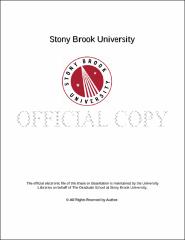| dc.identifier.uri | http://hdl.handle.net/11401/78352 | |
| dc.description.sponsorship | This work is sponsored by the Stony Brook University Graduate School in compliance with the requirements for completion of degree | en_US |
| dc.format | Monograph | |
| dc.format.medium | Electronic Resource | en_US |
| dc.format.mimetype | Application/PDF | en_US |
| dc.language.iso | en_US | |
| dc.type | Dissertation | |
| dcterms.abstract | The Sphingomyelin synthase (SMS1 and SMS2) enzymes constitute a class of transferases, belonging to the sphingolipid pathway and they catalyze the synthesis of sphingomyelin (SM). The role of sphingolipids has transformed, from being vital components of cellular membranes to mediators of various biological processes, such as proliferation, regulation of the cell cycle and differentiation. SMS catalyzes the transfer of the phosphorylcholine moiety from phosphatidylcholine to ceramide (Cer), generating SM and diacylglycerol (DAG). The role of SMS in cancer stems from its ability to regulate the levels of two bioactive lipids, Cer (mediator of anti-proliferative effects) and DAG (a mitogenic lipid), which have opposing effects on cell proliferation. Previous work from our laboratory has shown that SMS1 expression and activity is elevated in Chronic Myelogenous Leukemia (CML) and is mediated by the oncogene Bcr-Abl, a fusion tyrosine kinase. High SMS1 expression in CML has a pro-proliferative effect in these leukemic cells. My dissertation establishes the precise molecular mechanism via which Bcr-Abl regulates SMS1 expression. In the first part of my dissertation, I show that Bcr-Abl up-regulated the mRNA expression of SMS1 through a transcription-translation mechanism. Herein Bcr-Abl increased SMS1 transcription from a novel alternative transcriptional start site. This resulted in the generation of an mRNA with a short 5’UTR, which was translated 20-fold more efficiently, resulting in an increased SMS1 protein expression. Thus for the first time these results show that an oncogene (Bcr-Abl) increased protein abundance of its downstream target (SMS1) via mediating a shift in transcription initiation. In the second part of my dissertation, I elucidated the molecular mechanism resulting in the shift in transcription initiation of SMS1 in CML cells. I identified that the transcription factor GATA-1 bound to the promoter region and regulated transcription from it. This is the first description of an up-stream transcriptional regulator of SMS1. Interestingly, I showed that in a subset of AML cells with high GATA-1 expression, SMS1 transcription was also regulated in a similar manner and affected progression of cells through the cell cycle. Herein I identified a novel role of SMS in affecting cellular proliferation in AML cells. | |
| dcterms.available | 2018-07-09T13:58:59Z | |
| dcterms.contributor | Gergen, John Peter | en_US |
| dcterms.contributor | Luberto, Chiara. | en_US |
| dcterms.contributor | Czaplinski, Kevin | en_US |
| dcterms.contributor | Hannun, Yusuf. | en_US |
| dcterms.creator | Moorthi, Sitapriya | |
| dcterms.dateAccepted | 2018-07-09T13:58:59Z | |
| dcterms.dateSubmitted | 2018-07-09T13:58:59Z | |
| dcterms.description | Department of Genetics. | en_US |
| dcterms.extent | 229 pg. | en_US |
| dcterms.format | Monograph | |
| dcterms.identifier | http://hdl.handle.net/11401/78352 | |
| dcterms.identifier | Moorthi_grad.sunysb_0771E_13484.pdf | en_US |
| dcterms.issued | 2017-08-01 | |
| dcterms.language | en_US | |
| dcterms.provenance | Submitted by Jason Torre (fjason.torre@stonybrook.edu) on 2018-07-09T13:58:59Z
No. of bitstreams: 1
Moorthi_grad.sunysb_0771E_13484.pdf: 20062127 bytes, checksum: 6d0b307f0438e75a1111715b87c67b87 (MD5) | en |
| dcterms.provenance | Made available in DSpace on 2018-07-09T13:58:59Z (GMT). No. of bitstreams: 1
Moorthi_grad.sunysb_0771E_13484.pdf: 20062127 bytes, checksum: 6d0b307f0438e75a1111715b87c67b87 (MD5)
Previous issue date: 2017-08-01 | en |
| dcterms.subject | Genetics | |
| dcterms.title | Role and regulation of Sphingomyelin synthase 1 in Leukemia | |
| dcterms.type | Dissertation | |

